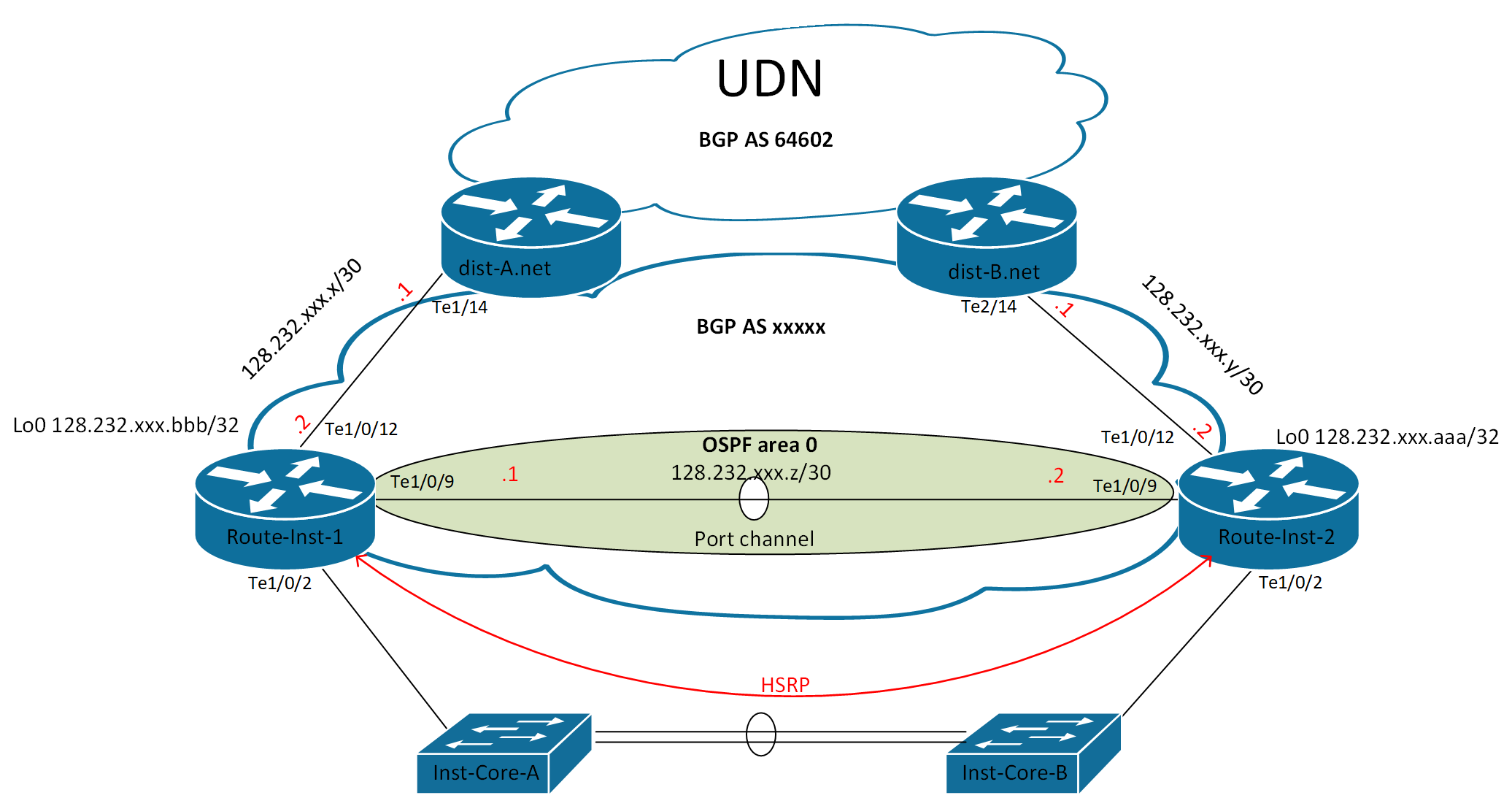BGP service run by UIS on managed Cisco Routers
The University Data Network (UDN) Border Gateway Protocol (BGP) service permits connections to institutions which are highly resilient and configurable. It is, however, a complex protocol and requires a significant degree of expertise to configure, maintain and diagnose faults.
The Managed Router Service (MRS) is designed to let institutions benefit from a BGP connection, without the need to maintain complex routers or understand the BGP protocol.
Contents
Basics
The MRS provides an institution with a pair of BGP-capable routers (typically the Cisco Catalyst C3850-12XS with an IP Services routing software licence). The routers are usually installed in physically-separate locations and configured as two independent physical routers (as opposed to the Split PoP service where the two devices are configured as one logical stack), interconnected at layer 3 with at least two diverse links.
The UIS will own and run the router hardware, performing any necessary upgrades or reconfiguration. As with the UDN PoP service, the hardware will be replaced, at the end of its lifespan, and an equivalent configuration installed on the new equipment.
Technical details
It is not required for an institution to understand the details of how the MRS equipment is configured but the information here provides some useful background information.
Each MRS router is typically connected via a single link to a UDN router, so the institution still maintains two connections to the UDN, but through separate hardware. The MRS routers are then directly interconnected, providing the resilience in the event of a failure of one of the UDN connections.
A separate eBGP (exterior BGP) peering is configured between each MRS router and the adjacent UDN router. This is used to exchange routes between the local network and the UDN backbone (e.g. send the routes used by the institution to the UDN and receive routes to UDN prefixes and the default gateway).
The OSPF (Open Shortest Path First) interior gateway protocol (IGP) and an iBGP (interior BGP) peering will be run between the two MRS routers on dedicated direct interconnection to provide connectivity in the event that one of the connections to the UDN fails. This connection should be more than one direct physical cable and provided through a Link Aggregation Group (LAG, also known as a port channel). The advertised Managed Router Service price does not include installation nor rental of these cables: if these are not provided by the institution itself, the UIS can organise these and the costs incurred in doing so will be recharged as part of the service.
A first hop redundancy protocol (FHRP), usually HSRPv2, is run on the two routers to provide redundant gateways for all institution's local VLANs (data, voice, wireless AP management, etc).
Split-site routing
If the institution prefers, the eBGP and HSRPv2 protocols can be configured to steer traffic to/from particular VLANs via a specific router; if there is a failure of that router or link, the traffic will fail over to the other link.
This configuration makes sense when there is an obvious split of prefixes between sites and it is desired that traffic does not unnecessarily traverse the link between the institution's sites.
In this situation, it can be advantageous to have separate wireless AP or voice VLANs for each site and this can be arranged.

Institutional network requirements
The institution's internal network should be configured to be redundant at layer 2, usually with a pair of core switches interconnected using multiple, diverse links. The institution must arrange this themselves, either using GBN circuits or their own internal links.
Depending on the institution's local network topology, it is also possible to use managed routers as core switches.
Prices
The MRS incurs an installation cost and an annual charge and is alternative to the PoP charges:
| Annual Charge | New Installation | Crossgrade Installation | |
|---|---|---|---|
|
R10G-12 — 2x Routers, 24x (16x usable) 10GE SFP+, 10GE uplinks |
£9,535 + interconnect |
£35,989 + interconnect setup |
£27,680 |
|
Circuit relocation |
- | £1,630 | - |
All prices are subject to VAT, where applicable.
Prices last updated 11th January 2023.
The cost of the interconnect between the managed routers will be recharged at cost and depend on the distance between sites and the path the circuit takes.
Last updated: 1 February 2021
